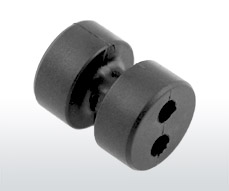Using Phenolics in Thermoset Molding Applications
 Phenolic, or phenolic molding compound, is a type of thermoset molding material. Phenolic materials have history dating all the way back to the original plastic, Bakelite, that derived from Leo Baekeland in the early 1900s. Even with a long history, phenolic thermosets are still commonly molded today for different applications and end products requiring heat resistance, electrical strength, and chemical resistance. Molded phenolic components exude excellent dielectric strength and electrical insulation, heat resistance, and chemical resistance. These properties allow phenolics to be molded for a variety of safety-critical components in Electrical, Automotive, and Industrial markets. Phenolics are compounded into a similar shape prior to molding as thermoplastics, in that they are compounded into in a granular form; filled with glass fibers, minerals, or bead fillers dispersed within the resin. Molding wise, phenolics are generally injection molded, but can also be compression or transfer molded. Injection molding phenolics require the use of a molding machine with a screw and barrel to plasticize the material prior to injection.
Phenolic, or phenolic molding compound, is a type of thermoset molding material. Phenolic materials have history dating all the way back to the original plastic, Bakelite, that derived from Leo Baekeland in the early 1900s. Even with a long history, phenolic thermosets are still commonly molded today for different applications and end products requiring heat resistance, electrical strength, and chemical resistance. Molded phenolic components exude excellent dielectric strength and electrical insulation, heat resistance, and chemical resistance. These properties allow phenolics to be molded for a variety of safety-critical components in Electrical, Automotive, and Industrial markets. Phenolics are compounded into a similar shape prior to molding as thermoplastics, in that they are compounded into in a granular form; filled with glass fibers, minerals, or bead fillers dispersed within the resin. Molding wise, phenolics are generally injection molded, but can also be compression or transfer molded. Injection molding phenolics require the use of a molding machine with a screw and barrel to plasticize the material prior to injection.
 Electrical components such as circuit breaker covers and breaker handles, terminal blocks, and electrical connectors are common applications molded from thermoset phenolics due to these desirable electrical properties, keeping the product assembly and components safe, even under a potential product failure. Automotive transmission and powertrain components utilize heat resistance and chemical resistance properties of phenolic for parts exposed to automotive fluids, oils, and grease. Likewise, the high temperature resistance allows phenolic parts to remain strong and durable even within applications experiencing high operating temperatures. Phenolic molding compounds are supplied by compounders such as PLENCO (Plastics Engineering Company), Sumitomo Bakelite, and Durez Corporation.
Electrical components such as circuit breaker covers and breaker handles, terminal blocks, and electrical connectors are common applications molded from thermoset phenolics due to these desirable electrical properties, keeping the product assembly and components safe, even under a potential product failure. Automotive transmission and powertrain components utilize heat resistance and chemical resistance properties of phenolic for parts exposed to automotive fluids, oils, and grease. Likewise, the high temperature resistance allows phenolic parts to remain strong and durable even within applications experiencing high operating temperatures. Phenolic molding compounds are supplied by compounders such as PLENCO (Plastics Engineering Company), Sumitomo Bakelite, and Durez Corporation.



Comments are closed